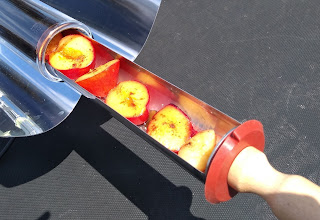My Solar Cooking Challenge
 |
| Spiced Plums in the GoSun Sport Whakataukī: He kai kei aku ringa. I have food at my fingertips. |
Kia ora Koutou,
I have dabbled with solar cooking over many years. I have had students make solar cookers, exploring the science and technology aspects. However, this year I have set myself a goal to cook at least seven things a week, to lower my carbon footprint. Seven things doesn't mean seven meals. Often it's just the rice or the potatoes. However, it can still be challenging. Some days are completely cloudy, so solar cooking is out of the question, but that happens everywhere. I just cook at least two things another day. The challenge for me is managing with the frequency of clouds passing over on what most Kiwis call a sunny day. We often get just 20 minutes of sunshine bright enough to cast a sharp-edged shadow before the next patch of cloud covers the sun. That means that most solar cookers stop cooking until the sun reappears.
Currently, I have two solar cookers which keep working well when the sun goes behind a cloud. These are glass tube cookers like the GoSun Sport above. They slow down as the clouds pass over, but they work like a thermos, storing any heat they have accumulated very well. They are my star performers, and I love them! However, their capacity is very small, so I am also exploring other models. We love our kai around here, and we're not dainty eaters!
About once a month, I'll add something to this blog to let you know what I have learned about solar cooking in this cloudy climate. In the meanwhile, here are some ways to make solar cookers work better in intermittent cloud:
- Bigger, shinier reflectors, if correctly aimed, help food to get hotter and cook faster. The more heat food takes in while the sun is shining, the longer it will take to cool down when clouds come over.
- Frequent realignment of solar cookers with the sun helps to catch as many rays as possible between clouds.
- Blacker pots and kettles convert light to heat more effectively.
- Trapping heat and avoiding wind chill better, whether by adding layers of plastic and glass, or by insulating opaque parts of the cooker, are important.
- Cook things which are routinely cooked at low temperatures, such as egg dishes and slow cooker meals. Have a thermometer to reassure you that you are still in the food-safe zone of 67 degrees C or above. Do not hesitate to finish cooking with conventional tools if the temperature drops below this.
- While thinner pots heat faster, thicker pots stay hot longer, so experimentation is in order as to which cookware works best in intermittent cloud.
- The Solar Cooking UK group on facebook is useful because the UK is at a comparable latitude to New Zealand.
- My most reliable solar cooker is a GoSun Sport from Taste of Sun, NZ.


Looking forward to it!!!
ReplyDelete